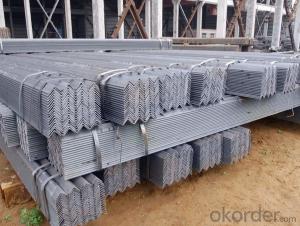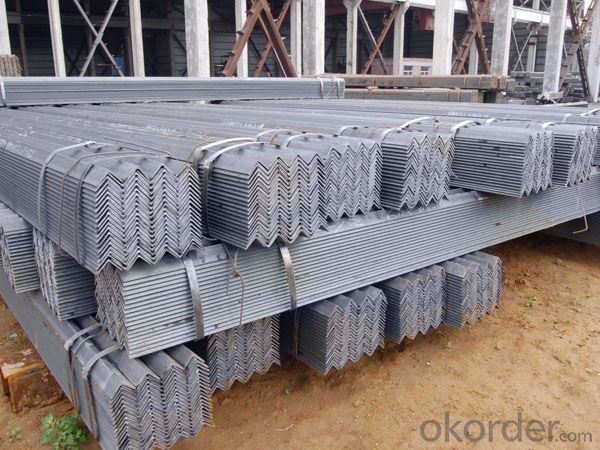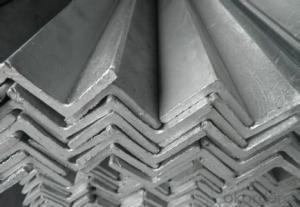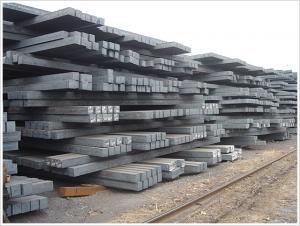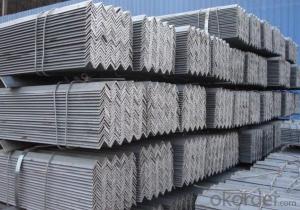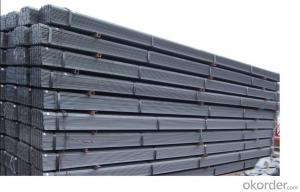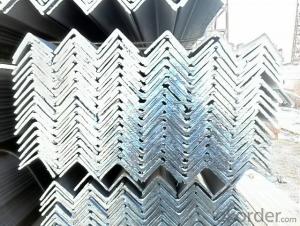Equal Angle Steel or Unequal Angle Steel 20mm-250mm
- Loading Port:
- Tianjin
- Payment Terms:
- TT OR LC
- Min Order Qty:
- 25 m.t.
- Supply Capability:
- 20000000 m.t./month
OKorder Service Pledge
OKorder Financial Service
You Might Also Like
Product Description:
OKorder is offering high quality Hot Rolled Steel I-Beams at great prices with worldwide shipping. Our supplier is a world-class manufacturer of steel, with our products utilized the world over. OKorder annually supplies products to European, North American and Asian markets. We provide quotations within 24 hours of receiving an inquiry and guarantee competitive prices.
Product Applications:
According to the needs of different structures, Angle can compose to different force support component, and also can be the connections between components. It is widely used in various building structures and engineering structures such as roof beams, bridges, transmission towers, hoisting machinery and transport machinery, ships, industrial furnaces, reaction tower, container frame and warehouse etc
Product Advantages:
OKorder's Steel I-Beams are durable, strong, and resist corrosion.
Main Product Features:
· Premium quality
· Prompt delivery & seaworthy packing (30 days after receiving deposit)
· Corrosion resistance
· Can be recycled and reused
· Mill test certification
· Professional Service
· Competitive pricing
Product Specifications:
Manufacture: Hot rolled
Grade: Q195 – 235
Certificates: ISO, SGS, BV, CIQ
Length: 6m – 12m, as per customer request
Packaging: Export packing, nude packing, bundled
Sizes: 25mm-250mm | ||||||||||
a*t | ||||||||||
25*2.5-4.0 | 70*6.0-9.0 | 130*9.0-15 | ||||||||
30*2.5-6.6 | 75*6.0-9.0 | 140*10-14 | ||||||||
36*3.0-5.0 | 80*5.0-10 | 150*10-20 | ||||||||
38*2.3-6.0 | 90*7.0-10 | 160*10-16 | ||||||||
40*3.0-5.0 | 100*6.0-12 | 175*12-15 | ||||||||
45*4.0-6.0 | 110*8.0-10 | 180*12-18 | ||||||||
50*4.0-6.0 | 120*6.0-15 | 200*14-25 | ||||||||
60*4.0-8.0 | 125*8.0-14 | 250*25 | ||||||||
FAQ:
Q1: How soon can we receive the product after purchase?
A1: Within three days of placing an order, we will begin production. The specific shipping date is dependent upon international and government factors, but is typically 7 to 10 workdays.
Q2: What makes stainless steel stainless?
A2: Stainless steel must contain at least 10.5 % chromium. It is this element that reacts with the oxygen in the air to form a complex chrome-oxide surface layer that is invisible but strong enough to prevent further oxygen from "staining" (rusting) the surface. Higher levels of chromium and the addition of other alloying elements such as nickel and molybdenum enhance this surface layer and improve the corrosion resistance of the stainless material.
Q3: Can stainless steel rust?
A3: Stainless does not "rust" as you think of regular steel rusting with a red oxide on the surface that flakes off. If you see red rust it is probably due to some iron particles that have contaminated the surface of the stainless steel and it is these iron particles that are rusting.
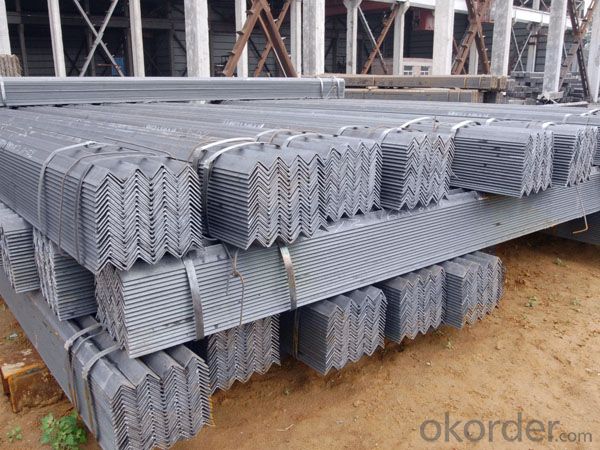

- Q: Can steel angles be used for signposts and traffic signals?
- Yes, steel angles can be used for signposts and traffic signals. Steel angles are commonly used in construction and engineering projects due to their strength and durability. They provide excellent support and stability, making them suitable for applications such as signposts and traffic signals that need to withstand various weather conditions and potential impacts. Additionally, steel angles can be easily customized and fabricated to meet the specific requirements of different signpost and traffic signal designs, making them a versatile choice for these structures. Overall, steel angles are a reliable and commonly used material for signposts and traffic signals due to their strength, durability, and versatility.
- Q: Where can you buy steel angles?
- You can buy steel angles at various places. One option is to visit a local hardware store or building supply store. These stores typically have a wide range of construction materials, including steel angles, available for purchase. Additionally, you can also check with metal suppliers or steel fabricators in your area. They often specialize in selling steel products, including angles, and can provide you with a variety of options to choose from. Another option is to explore online marketplaces and industrial supply websites. These platforms offer a convenient way to browse and purchase steel angles from a range of suppliers, often with the added benefit of being able to compare prices and read customer reviews. Whether you prefer to shop in person or online, there are numerous options available for buying steel angles to meet your specific needs.
- Q: What is the maximum temperature steel angles can withstand?
- The specific grade of steel being used determines the maximum temperature that steel angles can endure. In general, carbon steel can withstand temperatures of approximately 1000°C (1832°F) before its structural integrity begins to deteriorate. Nonetheless, the duration of exposure to high temperatures, the applied load, and the cooling rate after exposure are also influential in establishing the maximum temperature that steel angles can tolerate. To ensure that the steel angles are used within their safe temperature limits, it is advisable to consult the manufacturer's specifications or a structural engineer.
- Q: Galvanized steel angles under what conditions?
- Humid environment
- Q: What are the different types of corrosion protection coatings for steel angles?
- There are several types of corrosion protection coatings available for steel angles. These include galvanized coatings, which involve applying a layer of zinc to the surface of the steel to provide a barrier against corrosion; epoxy coatings, which are a type of paint that forms a protective layer on the steel surface; and powder coatings, which involve applying a dry powder to the steel and then curing it with heat to create a protective layer. Additionally, there are also organic coatings, such as acrylic or polyurethane, that provide corrosion protection for steel angles. The choice of coating depends on factors such as the environment in which the steel angles will be used and the desired level of protection.
- Q: Are steel angles suitable for manufacturing support brackets for conduits?
- Steel angles are indeed a suitable choice for the production of support brackets for conduits. In the realms of construction and manufacturing, steel angles are widely employed owing to their robustness and resilience. They offer exceptional structural reinforcement and possess the ability to endure substantial loads. Utilizing steel angles in the creation of support brackets for conduits guarantees the secure and steadfast positioning of said conduits, thereby averting any prospective harm or mishaps. Furthermore, steel angles can be readily tailored to meet particular criteria, including dimensions, configurations, and surface treatments, rendering them an adaptable option for the fabrication of support brackets for conduits.
- Q: Can steel angles be used in architectural applications?
- Yes, steel angles can be used in architectural applications. Steel angles are versatile structural components that can provide stability, support, and aesthetic appeal to various architectural designs. They can be used for framing, bracing, reinforcing, and creating unique shapes and forms in buildings, bridges, and other architectural structures.
- Q: How do you determine the required number of steel angles for a project?
- To determine the required number of steel angles for a project, you would typically need to consider the specific design and structural requirements of the project. This includes factors such as the dimensions and layout of the structure, the load-bearing capacity needed, and any specific codes or regulations that must be followed. A structural engineer or architect would typically perform calculations and analysis to determine the appropriate number of steel angles needed for the project.
- Q: What is the weight of a steel angle?
- The weight of a steel angle can vary depending on its dimensions and composition.
- Q: What is the maximum thickness of a steel angle?
- The maximum thickness of a steel angle can vary depending on the specific dimensions and specifications of the angle, but it is generally available in thicknesses ranging from 1/8 inch to 1 inch or even thicker.
Send your message to us
Equal Angle Steel or Unequal Angle Steel 20mm-250mm
- Loading Port:
- Tianjin
- Payment Terms:
- TT OR LC
- Min Order Qty:
- 25 m.t.
- Supply Capability:
- 20000000 m.t./month
OKorder Service Pledge
OKorder Financial Service
Similar products
Hot products
Hot Searches
Related keywords
